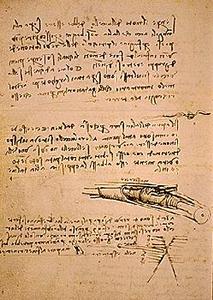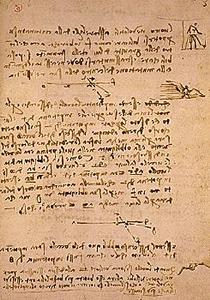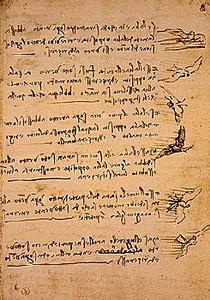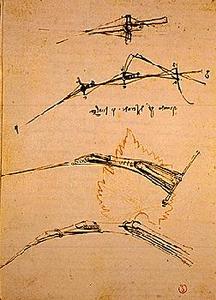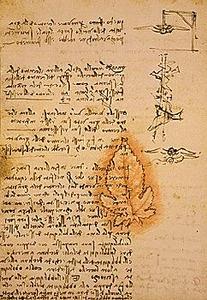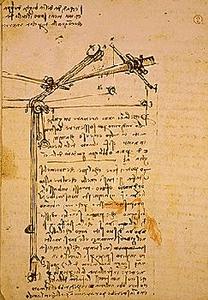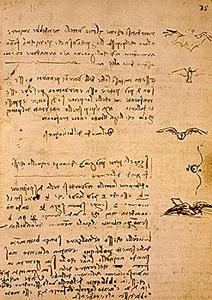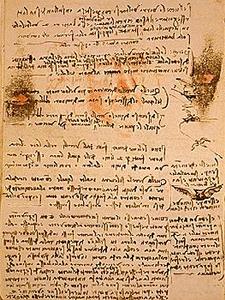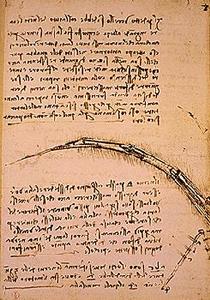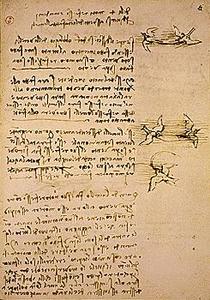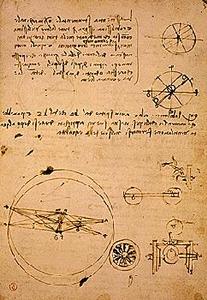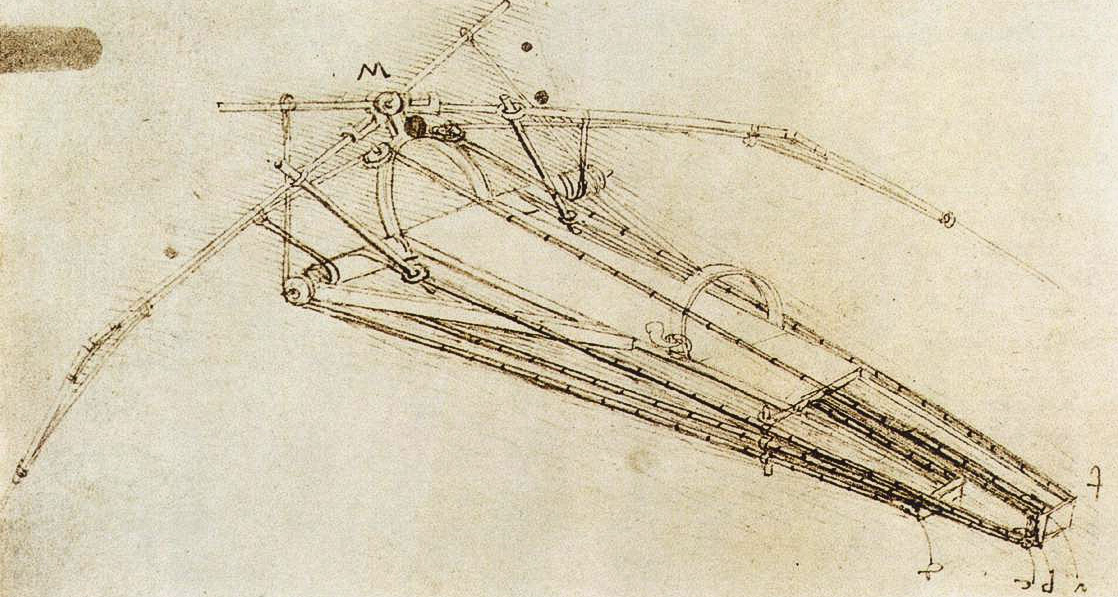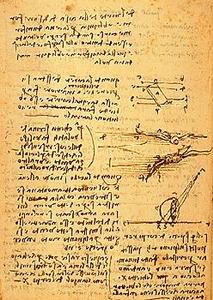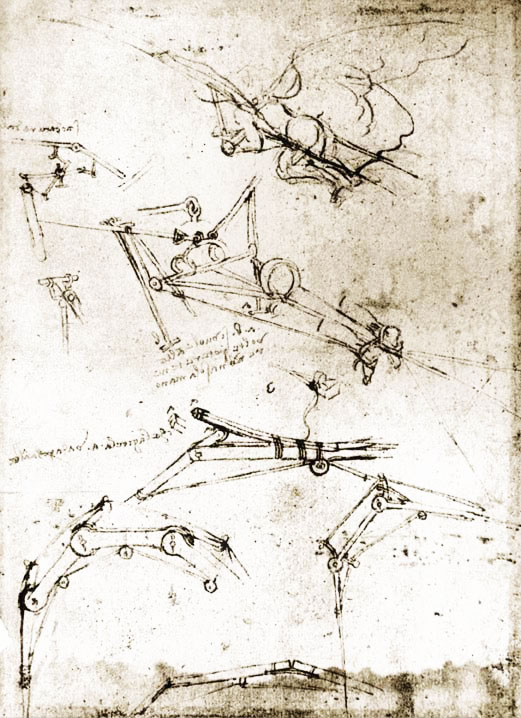Flight
"THE GREAT BIRD WILL TAKE ITS FIRST FLIGHT;-- ON THE BACK OF HIS GREAT SWAN,--FILLING THE UNIVERSE WITH WONDERS; FILLING ALL WRITINGSWITH HIS FAME AND BRINGING ETERNAL GLORY TO HIS BIRTHPLACE." -LEONARDO DA VINCI
"The Wright brothers, Orville (August 19, 1871 – January 30, 1948) and Wilbur (April 16, 1867 – May 30, 1912), were two Americans credited[1][2][3] with inventing and building the world's first successful airplane and making the first controlled, powered and sustained heavier-than-air human flight, on December 17, 1903"
It's unclear if Leonardo was actually able to build and fly one of his "flying machines" but there is no doubt that his ideas and designs would eventually be realized. Like most of Leo's inventions and designs, they were conceived of hundreds of years before anyone one else would. The tank, the parachute, the submarine, the automobile, robots.. there is a surprisingly long list. There is a reason he is considered the greatest genius of all time. He is also considered one of the most innovative and revolutionary painters. So you could only imagine how advanced and complex his art would become.
Most of da Vinci's inventions and ideas were locked away within his Journals that have only relatively recently been available to the general public. We are only now beginning to unlock the secrets that he left behind for us to discover 500 years later. Ready?
"The great bird will take its first flight;-- on the back of his great swan,--filling the universe with wonders; filling all writingswith his fame and bringing eternal glory to his birthplace." -Leonardo da Vinci
"The Wright brothers, Orville (August 19, 1871 – January 30, 1948) and Wilbur (April 16, 1867 – May 30, 1912), were two Americans credited[1][2][3] with inventing and building the world's first successful airplane and making the first controlled, powered and sustained heavier-than-air human flight, on December 17, 1903"
It's unclear if Leonardo was actually able to build and fly one of his "flying machines" but there is no doubt that his ideas and designs would eventually be realized. Like most of Leo's inventions and designs, they were conceived of hundreds of years before anyone one else would. The tank, the parachute, the submarine, the automobile, robots.. there is a surprisingly long list. There is a reason he is considered the greatest genius of all time. He is also considered one of the most innovative and revolutionary painters. So you could only imagine how advanced and complex his art would become.
Most of da Vinci's inventions and ideas were locked away within his Journals that have only relatively recently been available to the general public. We are only now beginning to unlock the secrets that he left behind for us to discover 500 years later. Ready?
Anonymous 1470
Parachute:
Although "Andalusian polymath Abbas Ibn Firnas" is credited with inventing the first "Parachute" around 852 - and another anonymous sketch of one was made in 1470 -Leonardo da Vinci could still be considered as having inventing it independently. It's hard to know if he had access or knew about the concept before he sketched and detailed it in his notebooks. Since he also had concepts for "Helicopters" and "Planes" the idea of a parachute is rather simple in comparison. It's interesting that he choose a pyramidal design instead of round - but this could have been due to the practicality of building it with the material available.
Helicopter
First called "Arial Screw" is a design from Leonardo for a devise capable of vertical flight. Today we call them Helicopters but they were not built until the 1900's. Leo designed it with human power being the "engine" but it's unlikely that one could be made to work with the materials available at the time. It's not that the design itself wouldn't work its that there wasn't a way to turn it with enough power for lift off. It wasn't until true engines evolved that one could be created that could lift not only itself but a pilot.
Ornithopter
It's no surprise that the first ideas of human flight stemmed from observing flying creatures. It's also obvious that when translating those concepts into something that could enable a human to fly would also take its cues from how they fly - that is by flapping their wings. Leonardo's design for his "Ornithopter" or an aircraft that uses flapping wings - was probably some of his first. He understood the complexities and nuances of flight enough to use a bat's wing as a basis instead of a bird's. How would you make feathers? You couldn't 500 years ago. So the only other option would be to use a bat's wing and instead of bone - use wood, and fabric for it's skin that is between it's digits. The problem - like almost all his other flight inventions - was that the materials were too heavy. If it takes a certain amount of "wing power" or wing size to lift a certain weight - then as you build it larger and larger the weight also increases. It might not be possible to build one with those certain materials. Not only that but since it's powered by a man flapping the wings - he may not be strong enough to produce the lift necessary for it to fly.
Airplane:
This would be more accurately called a "Glider" instead of an "Airplane." The difference between an Ornithopter and a Plane would be that the wings do not flap. Another source creates the lift required to keep it in air. Today's airplanes use engines to produce the forward momentum that creates the lift required. So when we say that Leonardo invented the first Airplane it's really that he invented a practical and realistic precursor to modern planes. If the pilot used his body to flap the wings it would be an Ornithopter. If the wings didn't flap and had no other means of propulsion it would be a glider. If the wings didn't flap but had another way to generate propulsion - a propeller - it would be an airplane. It's interesting that if we were to pick and choose from the various concepts and inventions of Leonardo we could essentially create a human powered - airplane. It's very likely that he actually did but didn't sketch it out or those designs were lost. (Only a small % of his journals have survived) All the knowledge and information to create a plane are in his notebooks - but there isn't a fully realized and designed prototype. It's like he realized that it wasn't possible during his life time - but knew that someday it would be. It would be like designing a space ship that would work in space but before there was a way to get it out of Earth's atmosphere.
He studied the flight of birds thoroughly and realized that heavier than air flight was possible. He designed his aircraft's with that knowledge and anticipated how they would be able to change direction and altitude. He realized that a majority of the time a bird was flying required no propulsion but rather that they used the air and their wings/bodies being moved only slightly (rather than being flapped) to "fly." So while a jet would eventually fall to earth if it's engines died a glider could stay in the air almost indefinitely without using any propulsion. It could use wind and high and low pressure to stay off the ground. The problem wasn't how to keep his plane in the air it was how to get it there. Another problem (as i've mentioned before) was the added weight and complexity needed to manipulate the wing's to move and change like a bird does. Each movement would require more levers and pulleys - and this would add even more weight. Today we have solved these problems with lighter materials. If Leonardo had access or knowledge of these kinds of materials there is little doubt he could have not only created a functional glider but take the idea even further and essentially create artificial wings that would allow a man to fly like a bird - or a bat. In a lot of ways this is substantially more complicated and sophisticated than how modern planes operate. Designing a plane without engines is a lot more difficult than to design them with engines that can provide enough lift for the weight of hundreds of tons of metal and plastic. Think about how much more complex creating an artificial bird that could fly would be to a modern airplane. It's the difference between a cheetah and a bicycle.
"THE GREAT BIRD WILL TAKE ITS FIRST FLIGHT;-- ON THE BACK OF HIS GREAT SWAN,--FILLING THE UNIVERSE WITH WONDERS; FILLING ALL WRITINGSWITH HIS FAME AND BRINGING ETERNAL GLORY TO HIS BIRTHPLACE." -LEONARDO DA VINCI
"The Wright brothers, Orville (August 19, 1871 – January 30, 1948) and Wilbur (April 16, 1867 – May 30, 1912), were two Americans credited[1][2][3] with inventing and building the world's first successful airplane and making the first controlled, powered and sustained heavier-than-air human flight, on December 17, 1903"







